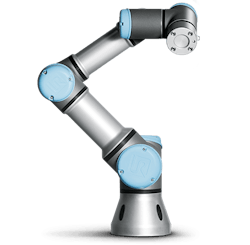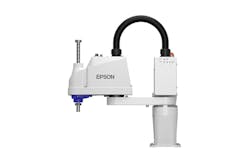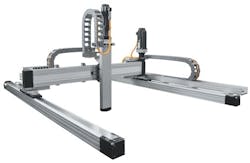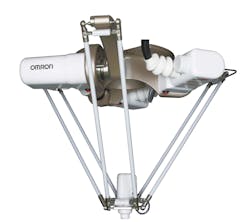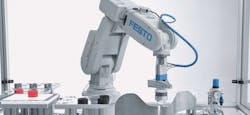Robotic technologies often captivate human attention for their broad—and still growing— autonomous operating capabilities. They also attract our attention because we can see how they’re changing the very face of industrial operations.
Like the first two installments in our Peer-to-Peer FAQ series (on sensors and cybersecurity), this FAQ begins with an overview of the technology in focus and then shares insights from system integrators and your end user peers across industry.
Industrial robots Industrial robots can generally be broken down into one of four categories: articulated, cartesian, SCARA, and delta.
- Articulated robots resemble the human arm and feature from two to 10 axes of motion and are often attached to a rotary base. Articulated robots with four to six axes are the most common robots of this type used in manufacturing. In some cases, articulated robots with up to six axes also feature an additional axis in the form of a linear transport system capable of moving the robot back and forth along a set path. This is sometimes referred to as a seventh axis in the case of six-axis robots, or a robot transfer unit otherwise. This additional axis is used to move the robot to different workstations along a line or between workstations on adjacent lines. Articulated robots are particularly useful for applications such as assembly, arc welding, material handling, machine tending, and packaging.
- Cartesian robots, sometimes referred to as linear or gantry robots, are bound by three linear axes which are defined by the cartesian coordinate system as the X, Y, and Z axes; in other words, these robots move up and down, in and out, and side to side. Cartesian robots allow end users to adjust the speed, precision, stroke length, and size of any movement, and are commonly used in CNC machines and 3D printers.
- SCARA (selective compliance assembly robot arms) robots function on a three-axis system similar to cartesian robots. However, they also feature rotary motion, allowing them to extend into confined areas and then retract when necessary. This can be useful when transferring parts from one work cell to another or when unloading workstations. SCARA robots are often used for assembly, painting, and palletizing, as well as biomedical production applications.
- Delta robots, also called parallel robots, possess three downward-facing arms connected to a single base mounted above the workspace. These robots can move at high speeds while maintaining delicacy and precision because the end effector is controlled by all three arms simultaneously, providing enhanced stability. Delta robots are commonly used for pick-and-place applications in the food, pharmaceutical, and electronics industries, as well as in packaging applications.
While this general description has long been used to denote the difference between industrial robots and cobots, that line is becoming more blurred. Today, some industrial robots possess aspects of collaborative capabilities as outlined in ISO standards 10218-1 and 10218-2. These collaborative capabilities—safety monitored stop, hand guiding, speed and separation monitoring, and power and force limiting—can all be achieved using sensors, control systems, and peripheral devices, some of which may already be integrated within a robot upon purchase, while others can be retrofitted to an installed industrial robot.
A description of ISO’s four collaborative robot capabilities:
- Safety monitored stop: Robots that can temporarily pause their operation when a human or other unknown object is detected in the work cell are engaged in a safety monitored stop. In these instances, the robot maintains power but cannot move, meaning that it will not need to be turned off and restarted. Robot restarts can be a lengthy process that were required before development of the safety monitored stop function. Robots engaging in a safety monitored stop automatically start themselves back up once the workspace is clear.
- Hand guiding: When a cobot is moved via direct, hands-on input from an operator, it is called hand guiding. When an operator engages in hand guiding, the cobot remains in a safety monitored stop until actuated via an enabling switch. Most cobots can be programmed via point-based or path-based teaching to perform certain tasks after being hand guided through the points or path.
- Speed and separation monitoring: This technology allows a robot to operate with a human nearby if a pre-determined distance between the robot and human can be maintained. This can be achieved using pressure-sensitive safety mats, light curtains, or laser area scanners, as well as through a combination of sensors and vision systems, to alert robots when something has entered its hazard envelope.
- Power and force limiting: Limitations on power and force can be achieved through design or by the addition of external control elements. Typically, it requires a robot with power or force feedback built in. These robots are generally smaller, slower, and less powerful than other robots, allowing them to be more easily adapted to work safely alongside humans. In cases where a robot possessing only power and force limiting collaborative capabilities are used, extensive risk assessments are required to ensure safe operation
Autonomous mobile robots Autonomous mobile robots (AMRs) are robotic carts that can navigate through an environment without the need for human guidance to carry a variety of materials between locations. Often, AMRs are seen as a replacement for automated guided vehicles (AGVs), which have long been used to automate movement of materials in industry. Whereas an AGV navigates by following wire strips or magnetic tracks along the floor, AMRs use a technology called light detection and ranging (LiDAR) instead. LiDAR works by using a laser sensor to measure the distance between the AMR and other objects. The lack of fixed infrastructure required to deploy AMRs makes them ideal for applications where flexibility is needed. In addition to being used for material handling tasks, AMRs can have articulated robots mounted on them to enable their use in applications such as bin picking and machine tending.
End user and integrator insights
Few advanced technologies are as associated with
automation as robotics. In fact, for many, the two
terms—robotics and automation—are synonymous.
But the truth is, robots are just one example of an
automated system, albeit an often complex and
highly flexible one. As such, robots are increasingly
part of the automated ecosystem that comprises
modern manufacturing. And with the advances being
made to robots that make them more flexible,
more capable, and more easily programmed, we’re
now seeing a level of robot adoption that surpasses
that of the robot adoption heyday in the automotive
industry in the 1980s.
To better assess the state of industry’s current attitudes toward robots, we surveyed nearly 60 industrial end users and system integrators that work in every vertical manufacturing industry—discrete manufacturing, batch manufacturing, and continuous processing. Most respondents were, of course, in the discrete and batch manufacturing industries (96%), as robots are not as widely used in the continuous process industries due to the nature of their often enclosed (i.e., within pipes) production operations.
Respondents indicated that, of the robot types used in their production operations, 73% are industrial robots, 39% are collaborative robots and, surprisingly, 30% are autonomous mobile robots (AMRs). Editor’s note: Respondents were allowed to select all the robot types used in their facility, thus the total amounts exceed 100%.
Interestingly, 83% of readers said they are looking to add robots—or more robots—in the next two years. Helping drive this figure is the fact that 29% of respondents currently don’t use any robots at all, and only 13% note that more than 50% of their production operations involve the use of robots.
Of those end users applying robots in their production operations, industrial robots have been in use at their plants for an average of 11 years, while cobots and AMRs have been in use for an average of six years.
End users also noted the main drivers behind their decision to use robots. When asked to rank the issues affecting their use of robots, 45% noted labor issues as the primary factor, while 30% said speed/throughput, and 20% cited quality as the main issues driving their decisions.
Cobot preferences The popularity of collaborative robots (cobots) in this survey highlights how quickly they have become accepted across industry. The impressive numbers indicated for AMR and cobot use highlight two clear factors: 1) industry’s growing acceptance of robot technologies; and 2) the ongoing labor issues faced by every industrial vertical.
Though integrator respondents largely agreed with the numbers noted by end users, the integrators said interest in cobots over the past five years has grown by about a third, though most end users still prefer industrial robots. In fact, integrators note that 33.3% of their clients currently prefer cobots, with the remainder preferring industrial robots.
This insight about preferences for industrial robot over cobots could lead to faster, more widespread adoption of new industrial robot control technologies now coming to market. These technologies, which can transform industrial robots into cobots, apply capabilities such as speed and separation monitoring to help industrial robots move outside the caged or otherwise protected environments they’ve traditionally operated within. We’ve seen this demonstrated with both large palletizer robots as well as smaller industrial pick-and-place robots.
Most integrators (60%) responding to our survey say that it’s still too early to tell if these new robot control capabilities will reduce the recent upsurge in interest for cobots. However, given industry’s existing preference for industrial robots over cobots, any technology that could enable industrial robots to operate as cobots has a lot of built-in upside potential. This doesn’t mean that cobots will disappear, of course, but that their use will become more targeted at the types of applications for which they are best suited, i.e., those applications in which an industrial robot could be considered overkill.
Mobile robots on the rise
While much of the attention on robot technologies in
industry tends to focus on articulated robots that can
grasp and move objects, autonomous mobile robots
(AMRs) have also been gaining a great deal of attention.
In fact, 100% of the integrators responding to
this survey said they have seen an uptick in interest for
AMRs among their clients over the past five years.
Two factors tend to figure into the increased interest in AMRs:
- The fact that they are autonomous and not automated guided vehicles (AGV) which require embedded or fixed guides on the factory floor for the AGV to follow.
- The flexibility of AMRs to go anywhere with cobotlike safety features that prevent them from colliding with people or objects means AMRs can handle many of the material handling task commonly handled by humans with hand- and platform-trucks or fork lifts.
Integrators noted that interest in AMRs among users is evenly split among the discrete and batch manufacturing industries, comprising about 80% of the market looking to use AMRs.
Though industrial robots and cobots still lead the way in terms of the type of robots end users are looking to implement, at 78% and 44%, respectively, 22% of end users are looking to implement AMRs in the near term.
One end user respondent said the most important piece of advice they can share is for users to understand the importance of their own production processes before installing a robot. “If a robot is bought without a good understanding of the technology or the maintenance requirements for converting a manual process into a robotic method, this can lead—in many cases—to the robot ending up in a corner and not being used.” To avoid this outcome, this respondent recommends conducting a study before purchasing a robot to help direct the correct implementation of that robot to ensure it will deliver the expected results.
Another respondent suggests that, prior to any robot purchase, users should create and run a realistic simulation of the application to ensure it works as envisioned. “Check with the manufacturer to see how realistic their simulation software is and also check for cycle times,” said this respondent. “Integration and communication with third-party components is also an important factor in making a final decision.”
“Take baby steps when integrating [robotic] automation into legacy manufacturing operations and perform a ‘design for automation’ assessment in the early stages,” advised another respondent.
A few other key pieces of robot selection and application advice from end users include:
- Spend the extra money to get a robot that will truly perform to your satisfaction;
- Use a reliable manufacturer and integrator; and
- Do your homework—make sure the robot operation is robust enough to handle your application.
Integrator recommendations include:
- Buy a robot that can outperform what you need today—it will pay off in dividends later as you learn from and expand your use of robots.
- Remember that supplier support is key when installing a robot to reduce the learning curve and get the robot into operation faster.
- Inquire about service support, lead times, and a user friendly interface.
Leaders relevant to this article:

